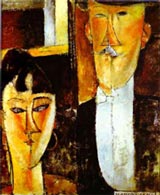

This issue was discussed in a very informative article in Zeek magazine titled “How Jewish is Modigliani?” where it was asked: “Given the location of the exhibition, questions remain regarding the significance of Modigliani’s Italian-Jewish background. How Jewish was he? How did it influence his art? And how Jewish do you have to be to be in the Jewish Museum?”
By all accounts, Modigliani benefited from a rich Sephardic heritage, aided by the fact that the part of Italy he lived in (Leghorn) had no ghetto walls and was extremely tolerant towards the Jews. “He is known to have frequently announced “je suis Modigliani, juif” — “I am Modigliani, the Jew” — and to have vociferously attacked anyone who made an antisemitic remark.” He had a Bar Mitzvah and a Rabbi officiated at his funeral. So why the question? Isn’t art created by a Jew, Jewish art by definition?
Apparently it’s not so clear. For instance, unlike his contemporary Chagall (“widely considered a Jewish artist”, Modigliani never experienced a strong measure of anti-semitism growing up. Modigliani made little use of Jewish themes in his work – no evocative shtetl scenes, no accoutrements of ghetto life, no use of “Jewish imagery and myth” etc.
“Perhaps Chagall’s art is “more Jewish” because Chagall’s Jewish roots include experiences of persecution and shtetl life. Perhaps it is because Chagall lived longer. Or perhaps it is because we do not recognize Modigliani’s comparatively cosmopolitan subjects and concerns as ‘Jewish’ in the same way as Chagall’s shtetl-dwellers are. Whatever the reason, the apparent dearth of Jewish subject matter in Modigliani leaves one in the uncomfortable position of having to determine if, how much, and in what way, Jewish background and identification makes art “Jewish.” It is this question which seems unanswerable. Unless a Jewish artist elects to make Jewishhness a topos of his or her art, even ironically, we are left with ambiguity.”
Well, it’s ambiguous if Judaism is defined on the basis of ghetto life and anti-semitism. That however is a very Eurocentric approach that ignores the historical experience of many Jews that was not defined by similar experiences of anti-semitism. It is also reflective of a very contemporary, secular Jewish approach whereby Jewish identity, stripped of most of its Jewish tradition, is left with only anti-semitism as a focal point of its distinctiveness.
I always thought that a Jewish identity based primarily on anti-semitism and victimhood kinda, well… sucked. The implication is that but for anti-semitism, one would never have opportunity to express one’s Judaism. I also think that the issue of Modigliani’s Jewishness diminishes his particular Jewish upbringing – a typical response from a primarily ashkenazic Jewish society almost blind to the existence of different Jewish experiences. Modigliani’s sephardic Jewish upbringing was by all indications very cosmopolitan and bereft of the influence of a society closed to his kind. His art work reflects this open minded, worldly sensibility. Why is that any less Jewish than fiddlers on roof tops and flying goats? So, to answer the question – How Jewish is Modigliani? Well… at least as Jewish as Chagall. Just as Jewish as any Jew. Why is that even a question?
The exhibition continues at the Jewish Museum in New York until September 19th. Two other exhibition sites follow: The Art Gallery of Ontario in Toronto, October 23, 2004-January 23, 2005; The Phillips Collection, Washington D.C., February 19 – May 29, 2005.
- Hawk Tuah Girl Haliey Welch is Not Jewish. Probably. - 8/9/2024
- Jews Blessed by their High Priests - 10/14/2022
- Foolproof Mufletta Recipe & Muflettapalooza / Mimouna Invite! - 3/26/2021






Thank you for great content. ????????????? ????????????? b??????? ?????av????
Title
[…]always a big fan of linking to bloggers that I really like but don’t get quite a bit of link really like from[…]
Title
[…]we like to honor quite a few other online websites around the internet, even when they aren’t linked to us, by linking to them. Beneath are some webpages worth checking out[…]
Title
[…]below you’ll come across the link to some internet sites that we feel you ought to visit[…]
Title
[…]usually posts some extremely fascinating stuff like this. If you are new to this site[…]
Title
[…]we came across a cool internet site which you might delight in. Take a appear in the event you want[…]
Title
[…]below you’ll obtain the link to some websites that we consider it is best to visit[…]
Title
[…]Sites of interest we have a link to[…]
uluslararas? evden eve nakliyat
Ciesz? si? z jego sukcesów, ka?dy jest okupiony pot??n? prac?, sercem i wysi?kiem. Na drodze chwa?y i s?awy zachowaj incognito.
Title
[…]check beneath, are some absolutely unrelated web-sites to ours, nonetheless, they may be most trustworthy sources that we use[…]
Title
[…]although internet websites we backlink to below are considerably not associated to ours, we really feel they’re actually really worth a go by way of, so have a look[…]
Title
[…]we came across a cool web page which you could take pleasure in. Take a appear in the event you want[…]
uluslararas? evden eve nakliyat
Title
[…]please take a look at the web sites we stick to, including this 1, because it represents our picks through the web[…]
Title
[…]that would be the end of this article. Right here you will come across some internet sites that we believe you’ll enjoy, just click the links over[…]
Title
[…]please visit the sites we adhere to, such as this 1, as it represents our picks in the web[…]
Title
[…]here are some links to web-sites that we link to due to the fact we think they may be worth visiting[…]
Title
[…]usually posts some really interesting stuff like this. If you’re new to this site[…]
Thank you for the post on your blog. Do you provide an RSS feed?
https://wg89.vip/
Hey there! I simply wish to offer you a big thumbs up for your excellent information you have got right here on this post. I am returning to your web site for more soon.
Title
[…]Sites of interest we have a link to[…]
https://www.electricalvolt.com/
Hello there! This article couldn?t be written any better! Looking at this post reminds me of my previous roommate! He constantly kept talking about this. I’ll forward this information to him. Pretty sure he’ll have a very good read. Thanks for sharin…
ye?ilyurt escort bayan sitesi telefon numaras?
https://www.fda.gov/inspections-compliance-enforcement-and-criminal-investigations/warning-letters/disinfect-shield-613716-05062021
I truly love your blog.. Excellent colors
alaca escort bayan sitesi telefon numaras?
Introducing the fastest locksmith in London and Surroundings!
https://www.goconvertfile.com/otf-converter.html
Next time I read a blog, I hope that it does not disappoint me as much as this one. I mean, I know it was my choice to read, however I really thought you’d have something useful to say. All I hear is a bunch of crying about something that you can fix…
https://heavy.news
After going over a handful of the articles on your blog, I seriously appreciate your technique of writing a blog. I saved as a favorite it to my bookmark webpage list and will be checking back in the near future. Please visit my website too and tell me…
Lori Cahan-Simon found this very interesting article, from Aug 6, ’04, about the new Modigliani exhibit at New York’s Jewish…
How much do I love the new blog Jewlicious? Looks like they’ve been up and running for a month now, and they’re already soooo much better than the beter-known Jewschool, whose “Orthodox anarchist” bullshit got real old real fast. Hey, we get it, Je…
By the way, this series of comments is certified 24% EVIL by the Gematriculator
Dude. You may as well be permanently “drunk.”
…and I’m hungover, not drunk. It means I WAS drunk
I’m with neither of you. To be Jewish Art isn’t interest relative; that would imply that if you dont’ want to know anything but just look at a picture, it couldn’t have jewish content. Clearly you can miss the jewish content even if you are not looking for it. As for ck, please. you know the inference pattern from ‘X made by jew -> Jewish X’ is fallacious. For instance, a fellow named David Kaplan wrote one of the more famous papers in the philosophy of language called ‘Demonstratives’, which contains a good hard look at what the meaning of ‘that’ used demonstratively as well as a model theoretic account of context and indexicals like ‘i’,’now’ and ‘yesterday’. Your’e going to tell me that that is *jewish* philosophy? You’ll have a lot of angry real jewish philosophy writing fellows at your door. Lucky for you, they are all weiner academics. Man I am hungover. No wonder all the rambling. Forgiveness, please!
What is Jewish music? Uh… the Ramones?
I admit the whole Jewish/Art thing is a bit of a canard – Jewish art can be:
1. Art made by Jews or
2. Art with some sort of Jewish theme
Ultimately, does it really matter?
By the way 8opus, thanks for the comment and all and for the record, your email address never gets displayed on the site and I most certainly do not collect the addresses for spam purposes. I hate spam. Just for the record …
Hey.
Modigliani’s art: Jewish art? I don’t know if it’s a very useful term — it prob’ly depends on what the person using it wants to know.
If they’re trying to figure out what art made by Jews says about Jewish integration into life in 19th c Italy and France then, sure, they want to consider Modigliani. (Integrated.) If they’re trying to learn more about the marriage of Jewish themes with European art styles or how painting has been undertaken with respect for traditional Jewish prohibitions on graven images, then Modigliani’s not such a great example to consider.
So it’s just one of those things. (Sort of like the nutty and never-ending what is Jewish music discussion.) Should the Jewish Museum in NYC show him? Why not — he was Jewish, he was a famous painter, sounds good to me.
You’re sooo literal-minded Stenis sur la menace. Chagall’s paintings were reflective of his experience which happenned to include ashkenazic Jewish iconic imagery. Thus, no one has a problem characterizing his art as “Jewish.” Modigliani’s experiences were different from Chagall’s – but does the absence of readily identifiable Jewish imagery render art created by a Jew any less Jewish? Does all Jewish art HAVE to contain, I dunno, bagels? or fiddlers? or dancing Hassids? Geez, I hope not.
As for your example, pork made by a Jew is definitely more Jewish than pork made by a non-Jew.
Art made by a jew doesn’t really seem to make it Jewish art anymore than pork made by a jew makes it Jewish food. That isn’t to say that Modigliani shouldn’t be in the museum; but I don’t like the inference pattern you are using at all.